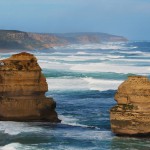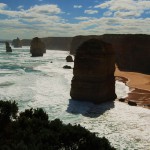Port Campbell National Park. The Twelve Apostles
Not far from Melbourne, the capital of Victoria State, there is a National Park Port Campbell with the world’s famous coastal rock formations that are called the Twelve Apostles. Since the National Park is relatively close to Melbourne and the trip to the Twelve Apostles takes less than 8 hours, we decided to devote our last full day in Melbourne to this legendary site of the Green Continent.
The road to the Twelve Apostles lies along the scenic coast of the Indian Ocean, which has been favoured long ago by the indigenous people and tourists, and which is called The Big Ocean Road. This is one of the most beautiful coastal roads – it offers wonderful views of the ocean, quiet towns on the shore and fishermen villages. The Big Ocean Road lies between beautiful cliffs, going past waterfalls, through a tropical forest; one can see astounding sights from here of the ocean expanses and sunken ships. One of the most impressive parts of the journey is the National Park Port Campbell.
This National Park’s peculiar characteristic is its coastal line. Along the entire shore, for hundreds of kilometers rocky islands of peculiar forms are scattered in the shapes of pillars, wedges, grottos, chimney tops and arches. But the most scenic site of the National Park is a place, which is called the Twelve Apostles. Originally, the place was called “Pig and Piglets,” but that name was changed in the 1950s to the “Twelve Apostles” for the purpose of attracting tourists, although there were only 9 rocks in the group. At present, there are only 8 rocks, because one of them crumbled down in 2005, succumbing to the influence of erosion and the impact of waves.
Apart from The Twelve Apostles, the tourists’ attention is attracted by the rock formations under the names London Bridge, The Baker’s Oven, The Sentinel and the Cave of Thunder. The Twelve Apostles and London Bridge, as well as standing nearby rocks Sentinel, Baker’s Oven and Thunder Cave – are links of the same ancient chain.
Port Campbell stack rocks consist of limestone, which was formed 26 million years ago, when all this territory was under water. As sea animals died, millions of minute skeletons rich in calcium (carbon) were accumulating on the sea bed. Gradually, above soft clay bed, a layer of limestone was formed, up to 260 meters deep. Around 20.000 years ago, during the last glaciation, sea level decreased and the rocks surfaced above the water. Wind, rain and tides crushed upon the soft slopes and throughout many centuries every 20—30 years a piece of rock would break apart and fall into the ocean. In some places the coast line retreated evenly, without leaving any traces of the former shape, while in other places, softer sections crumbled sooner and pillars and arches were formed, which we see there today.
Fierce winds rage over the Indian Ocean here, the so-called Roaring Forties: gigantic storm waves cut out ledges in the limestone at the height of up to 60 meters above the tide level. An opening near the Thunder Cave shows how the sea breaks through the soft rocks to the dry land. Here the water thunders under the ground in a 400-meter tunnel, cut by the waves in the rocks. In some places the tunnel’s roof fell in, and through these windows one can see the bubbling water below.
The beautiful scenery of these rocks attracts not only the multitudes of tourists. Birds also come here – for instance, mutton bird. They mate on the rocky ledges of the biggest cliff – Mutton-Bird Island, arriving here at the end of September from Siberia. To do this, they cover the distance of 14400 kilometers, crossing the Pacific Ocean.
Nests are built very close to each other on the island; birds are using every suitable crack here. At the safe height birds can bring up their youth, not endangered by humans or rats.
Other birds — albatrosses, boobies, cormorants and petrels — also come to the feast. In winter, on their way to Antarctic, southern whales swim past these shores to the places of their reproduction in the Big Australian Gulf. Some linger here for mating, but most of the whales that can be as much as 15 meters long go further, along the shore, not intimidated by the stormy waves and cliffs.



